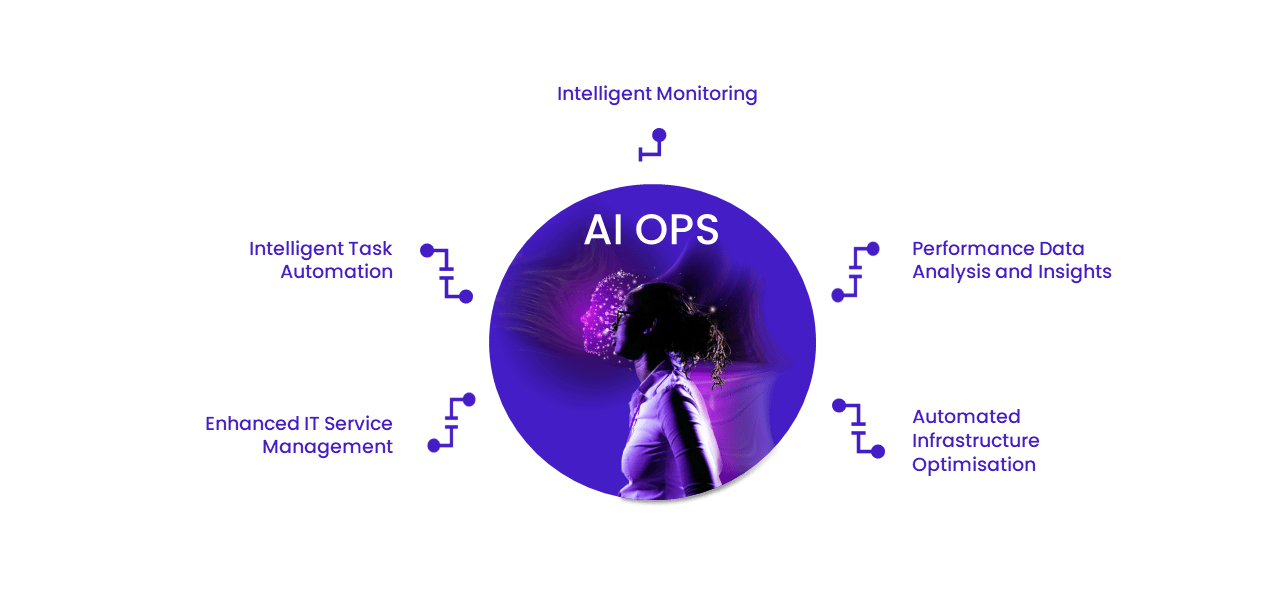AIOps: The Secret Engine Behind Next-Gen IT Performance
Published May 14, 2024
- Data & AI
- IT Strategy & CTO Advisory

The transformative power of technology is more evident than ever, reshaping the landscape of business operations and IT infrastructure. There has never been a time where organisations have had to evolve more quickly to meet expectations.
Transformation is not a luxury; it’s a necessity.
Wavestone’s ‘Tech leaders of the future’ series explores the latest digital and technology trends with Tom Lawrie, collaborating with Global industry experts. Discover practical advice on how you can successfully implement these new technologies to enable Performance Improvement.
AIOps: The Secret Engine Behind Next-Gen IT Performance
Organizations today grapple with the dual challenge of harnessing the transformative power of new technologies to enhance business operations while contending with the burden of legacy technical debt. This is a high-stakes game. The potential for failed investments and reputational damage are very probable risks that must be mitigated without losing out on competitive advantages that new innovations may help secure.
In the context of running an efficient IT operation, the application of AI to age-old problems around IT service management, error, and anomaly detection, streamlining and automating development and engineering practices, within well-defined security guardrails can prove to be a panacea for IT leaders.
AIOps is more than a buzzword, it is a potent ally when adopted in the right way and for the right use-cases.
Here are the 5 proven ways in which AI can significantly optimize and enhance your IT operations:

An AI-driven predictive analytics & maintenance platform can help identify potential issues across the whole length and breadth of the IT stack before they cause outages. The problem with traditional IT monitoring tools is that they don’t provide insights into the problem, just a deluge of events and warnings. AIOps can help make sense of this by analysing relatedness of events and warnings, separating the signal from the noise and provide teams with a clear path of action. In our experience, this can result in a significant 15% – 20% improvement in metrics such as Mean Time to Detect (MTTD) and Mean Time to Investigate (MTTI).
Additionally, these capabilities can be extended to enhance an organisation’s cyber security posture through advanced anomaly detection, vulnerability scanning as well as improved preparedness for dealing with zero-day threats and security policy violations.
Example:
Using AI powered monitoring can significantly improve network capacity management, application performance management, and even enable proactive service level management across the entire IT stack. AIOps can further help secure the design and development lifecycle and undertake automatic rules based actions against suspicious activity or policy violations.
Today’s complex IT estates produce a treasure trove of operational data and events that traditional tools find hard to both ingest and provide insights on. AIOps platforms provide powerful capabilities that can ingest large structured and unstructured data sets in real-time and perform sophisticated analytics to enable quick decision-making for IT leaders.
Example:
Correlating event data with obsolescence data over various time periods can enable decision makers to focus efforts and investments on the most critical IT modernization needs of the business.
AI can optimize resource allocation by constantly analyzing data and adjusting resources in real-time. This ensures that workloads are efficiently distributed based on demand and needs, leading to enhanced cost management of multi-cloud estates. AIOps coupled with a robust FinOps operating model can deliver significant cost savings for organizations that have significant developer-generated cloud spend.
Example:
Automated optimization of cloud storage tiers based on resource utilization patterns and modelled workload distribution can help reduce cloud spend.
AIOps enables ITSM professionals to manage services end-to-end rather than reacting to breached thresholds for individual components. It allows them to set system thresholds based on impact to the end-to-end service as per their ITSM framework, helping IT departments run more efficiently and reduce critical incidents by more than 50% on average.
Example:
AI enabled ITSM can take nuanced and automated actions based on modelled impact to the service, in situations such as server failures during normal load hours as opposed to server failures during peak load hours. In the former instance, the faulty server could be safely made offline, whilst in the latter the automated action could be to add additional capacity to the server farm to protect customer experience.
This is a key underlying capability of AIOps platforms that can be used in multiple scenarios and use-cases. It frees service management personnel from manually having to cobble together data from various sources to decide on the course of remedial action. It allows organizations to analyze and correlate disparate data streams to quickly get to the root cause of a problem and automate remedial action with little to no human intervention.
Example:
Task automation examples may range from tactical activities such as periodic deletion of disk logs to more sophisticated use-cases such as automated release and deployment management of code to automatic detection of personally identifiable information and enforcing appropriate data privacy controls on flagged data sources.
The Road Ahead
The future of IT operations is poised to become increasingly automated, intelligent, and adaptive. The difference between leaders and laggards will largely be predicated on their abilities to adopt and uplift capabilities in a way that provides rapid value. AIOps has clearly emerged as one such capability and has consistently gained traction over the last 2-3 years.
While GenAI may be grabbing all the headlines recently, platform vendors across all existing service management domains and market segments are aggressively enhancing their AI capabilities to bring value to existing clients; the most mature players aggregating these capabilities into a single strategic enterprise platform to maintain dominance.
Organizations that are early to spot these opportunities and willing to invest in incremental innovation are best placed to super-charge their IT operations and achieve sustainable transformation.